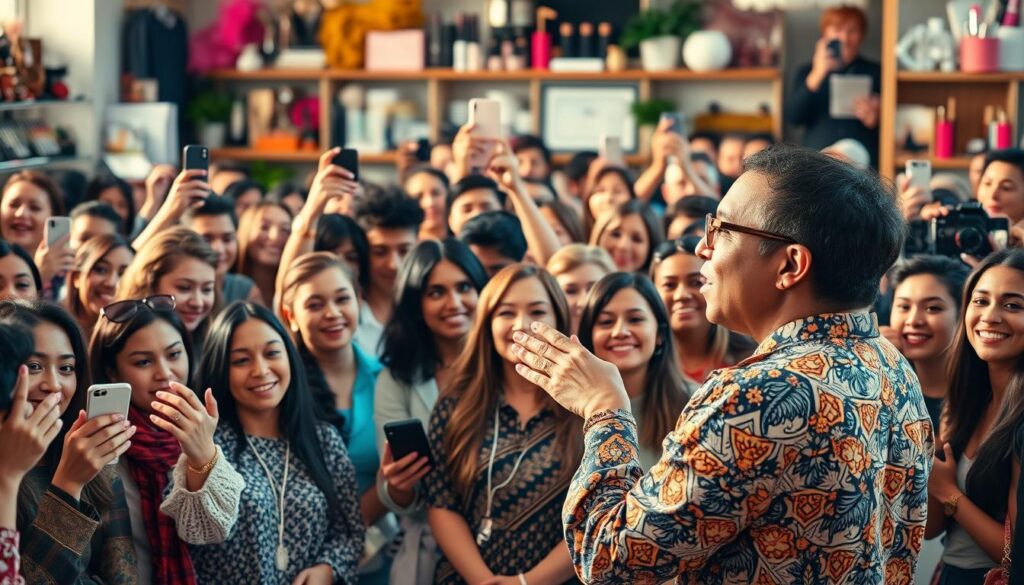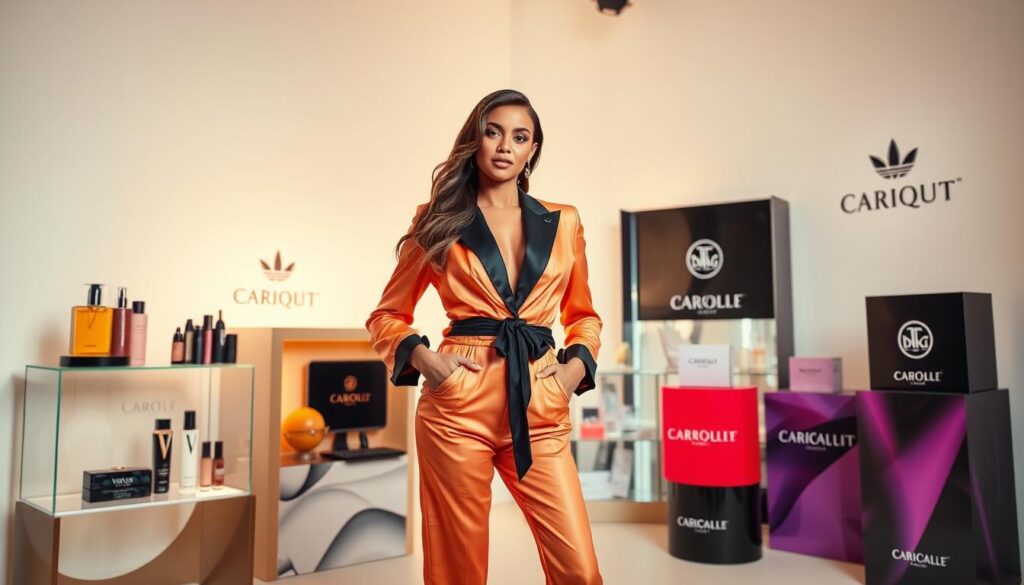Ever wondered why some creators dominate the world fashion scene while others struggle to gain traction? The answer lies in strategy, authenticity, and smart brand partnerships. Today, influencers shape trends and redefine modern style, making this career path more appealing than ever.
With 72% of Gen Z considering this profession, the influencer market has exploded. The industry now values at $21B globally, offering endless opportunities. Unlike traditional celebrities, influencers build deeper connections with their audiences through relatable content.
Platforms like Afluencer help creators secure brand deals, while FTC guidelines ensure transparency. Whether you’re starting or scaling, understanding these dynamics is key to success.
Key Takeaways
- Influencers redefine trends with authentic audience engagement.
- The industry is worth $21B, offering vast career potential.
- Gen Z sees influencing as a viable professional path.
- Brand partnerships require strategic planning and FTC compliance.
- Platforms like Afluencer streamline collaborations.
What It Takes to Be a Fashion and Beauty Influencer
Breaking into the world of style and glamour demands more than just a passion for trends. It requires strategy, consistency, and a deep understanding of your audiences. With 89% of marketers valuing influencer partnerships, this career path offers real potential.
Defining the Role of an Influencer
Modern creators blend artistry with entrepreneurship. They curate looks, share tips, and build trust through authentic content. Unlike traditional celebrities, influencers engage directly with followers, turning everyday moments into trendsetting opportunities.
Success depends on niche expertise. Nano-influencers (1K-10K followers) often earn $100-$500 per post, while mega-influencers command $10,000+. Each tier serves brands differently, from hyper-local reach to global campaigns.
Why Fashion and Beauty Influencing Is a Smart Career Choice
The industry’s $21 billion valuation proves its staying power. Platforms like Instagram and TikTok reward creativity with monetization options. Emma Chamberlain’s coffee collaboration, valued at millions, shows what’s possible.
Key advantages include:
- Flexible schedules and location independence
- High demand for relatable, diverse voices
- Multiple income streams from sponsorships to affiliate sales
Assessing Your Passion and Readiness
Before diving in, evaluate your commitment. Can you produce daily content? Handle constructive criticism? The FTC requires clear sponsorship disclosures, adding legal considerations to your workflow.
Take this quick self-check:
- Do you naturally analyze emerging trends?
- Can you negotiate fair brand partnerships?
- Are you comfortable on camera and in writing?
If you answered yes, you’re already ahead. The road requires resilience but offers unmatched creative freedom.
How to Be a Fashion and Beauty Influencer: Building Your Brand
Standing out in the crowded digital space starts with a distinct personal brand. Your identity—from aesthetics to messaging—determines whether audiences remember you. Research shows 68% of followers recall influencers with cohesive color schemes.
Finding Your Unique Style and Niche
Specialization drives success. Korean beauty enthusiasts attract different followers than gender-neutral stylists. Analyze @shereenw’s pivot from thrift hauls to luxury content—her niche shift doubled engagement.
Ask yourself:
- What trends do I naturally gravitate toward?
- Can I teach others about this niche?
Creating a Consistent Visual Identity
Cohesion matters. Use Canva templates for Instagram highlights or pair fonts like Montserrat with Playfair Display. Before rebranding, @lizzyhadfield’s feed mixed tones; after standardizing warm filters, her collaborations grew by 40%.
Crafting an Engaging Social Media Bio
Top bios blend credibility and calls-to-action. Example: “Vogue-featured stylist helping you master capsule wardrobes ↓ Shop my LTK”. Emojis (🎀) break text visually, while keywords like “sustainable fashion” aid discoverability.
Pro tip: Update bios monthly to reflect evolving brand goals.
Mastering Content Creation for Maximum Impact
Visual storytelling powers successful influencer careers today. Creating high-quality content requires the right tools, techniques, and timing. With 68% of audiences preferring polished media, investing in your setup pays off.
Essential Tools for High-Quality Photos and Videos
The Sony ZV-1 camera ($748) excels in autofocus, while the iPhone 14 Pro rivals DSLRs for quick edits. A Ring Light Pro+ ($149) ensures even lighting—key for photos and videos.
Prioritize these essentials:
- Stabilizers for smooth transitions
- External mics for crisp audio
- Editing apps like Lightroom or CapCut
Lighting and Composition Tips
Natural light works best near windows. For DIY setups, place two lamps at 45-degree angles and a backlight to reduce shadows. This mimics professional creating high-quality content studios.
Rule of thirds: Position subjects off-center for dynamic shots. Use grids in camera apps to align elements.
Diversifying Your Content Strategy
Mix formats to keep feeds fresh. Post OOTDs on Mondays, trend breakdowns Wednesdays, and Q&As Fridays. TikTok’s #SilhouetteChallenge shows how viral trends boost visibility.
Platforms reward consistency. Instagram peaks Wednesdays at 11 AM EST, while TikTok engagement spikes Fridays at 7 PM.
Growing Your Audience Through Engagement
Engagement transforms casual viewers into dedicated followers. Unlike passive scrolling, active interactions—comments, shares, saves—signal algorithms to boost your visibility. Platforms prioritize creators who foster real connections with their audience.

Building a Loyal Community
James Charles’ strategy proves the power of personalized replies. Responding to comments within 2 hours increases engagement by 25%. Treat followers like friends: ask questions, celebrate milestones, and share behind-the-scenes moments.
User-generated content strengthens bonds. Encourage hashtags like #MyHudaStyle for reposts. Sephora’s Squad collective grew 3x faster by spotlighting fan creations.
Leveraging Instagram Stories and Live Videos
Polls and quizzes spike interaction by 48%. Use them to crowdsource opinions on trends or products. Live streams thrive with preparation:
- Test lighting and audio beforehand
- Prepare a question bank for Q&As
- Pin featured products for easy access
Collaborating with Other Influencers
Co-branded giveaways attract new followers efficiently. Partner with creators in adjacent niches—like skincare experts if you focus on makeup. Cross-promotions expand reach without paid ads.
The 70/20/10 content mix balances value and promotion: 70% educational, 20% entertaining, 10% sponsored posts. This keeps audience trust intact while monetizing.
Networking in the Fashion and Beauty Industry
The right connections can accelerate your rise in the style industry. From backstage at NYFW to virtual summits, every interaction builds your reputation. Smart networking turns casual contacts into lucrative partnerships.
Attending Events and Pop-Ups
Events like Beautycon or Revolve Festival offer face-time with brands. NYFW access costs $500–$2k, but free pop-ups at local boutiques provide similar opportunities. Bring business cards and a 30-second pitch.
Pro tips:
- Research attendees beforehand via event hashtags.
- Follow up within 48 hours with personalized LinkedIn invites.
Guest Blogging and Cross-Promotions
Pitch trend analyses to media outlets like Byrdie. Example email template:
“Subject: Fresh Take on [Trend] for [Outlet’s Audience]”
Highlight your expertise and propose a unique angle. Cross-promote with bloggers in complementary niches to double reach.
Joining Influencer Communities
Facebook groups like Beauty Blogger Babes (45k members) share brand leads. Exclusive Discord servers, such as Fashion Influencer Insider, offer private job boards. Engage daily—answer questions before asking for favors.
Local marketing matters too. Co-host trunk shows with boutiques, splitting promo duties. These micro-collabs often lead to bigger partnerships.
Getting Noticed by Brands
Brand partnerships define success in the digital creator space. Standing out requires more than great content—it demands strategic outreach and smart visibility tactics. Data shows creators using structured approaches land 63% more collaborations than cold pitches.

Tagging Brands Strategically
The 1:2:1 formula maximizes exposure. Tag one mega-brand, two mid-size companies, and one startup per post. This mix signals credibility while supporting emerging brands.
Example: A skincare post could feature @EsteeLauder, @DrunkElephant, and @YouthToThePeople. Startups often engage faster, creating opportunities for long-term ties.
Pitching Yourself to Smaller Brands
Local boutiques and indie labels offer entry points. ColourPop’s nano-influencer program boosted sales by 18% through micro-creators. Tailor pitches with:
- Audience demographics matching their ideal customer
- ROAS metrics from past sponsored posts
- Clear UGC rights terms (e.g., repurposing limits)
Using Influencer Marketing Platforms Like Afluencer
Platforms streamline connections. Afluencer’s vetted brands reduce negotiation time, with a 63% partnership success rate. Optimize profiles with:
- Professional media kits (include age ranges and top locations)
- Rate cards scaled by follower tiers (nano: $100–$500/post)
- Links to top-performing content
Case Study: A nano-creator earned $8k/month through Afluencer’s skincare brand matches—proof that the right influencer marketing platforms unlock earning potential.
Monetizing Your Influence
Sustainable careers in digital content demand diversified revenue streams. Top creators earn through sponsorships, affiliate sales, and digital products. The key lies in balancing authenticity with smart marketing strategies.
Securing Sponsored Posts and Partnerships
Brand partnerships should align with your niche and values. Instagram posts average $8 CPM, while YouTube commands $12. Always review contracts for these red flags:
- Unlimited content usage rights
- Overly restrictive exclusivity clauses
- Payment terms exceeding 60 days
Negotiate rates using scripts like: “Given my 5.8% engagement rate, $750 per post reflects fair value.” Huda Kattan’s empire began with such strategic brand deals.
Exploring Affiliate Marketing
LTK offers 15% commissions versus Amazon’s 4%. ShareASale works well for emerging brands, while Impact Radius suits enterprise campaigns. Disclose affiliations clearly—FTC fines reach $16,000 per violation.
Top performers:
- Link styling guides in bio tools
- Create swipe-up Story templates
- Track conversions with UTM codes
Diversifying Income Streams
Digital products convert followers into customers. Lightroom presets sell for $15-$50, while e-books generate passive income. Online courses on trend forecasting can earn $5k+ per launch.
Remember these tax deductions:
- Home office square footage
- Equipment depreciation
- Software subscriptions
Each revenue stream strengthens your career against algorithm changes. The most successful creators treat their channels like media companies.
Conclusion
Your journey in the digital style space starts now. With a 12-month plan, track progress: grow followers by 30% in 3 months, secure 5 brand deals by month 6.
New platforms like Lemon8 offer fresh opportunities. Balance hustle with self-care—try Headspace for creator burnout.
Ready to level up? Join Afluencer today with code STYLE20 for exclusive perks. Grab your free media kit template below to pitch brands confidently.
Every iconic career fashion influencer began with one post. Let yours be the inspiration for others.
FAQ
What skills do I need to succeed as a fashion and beauty influencer?
Strong visual storytelling, creativity, and trend awareness are key. You’ll also need social media expertise, consistency, and the ability to engage authentically with your audience.
How do I find my niche in the fashion and beauty space?
Identify what excites you most—whether it’s sustainable fashion, luxury beauty, or budget-friendly styling. Your passion will help you stand out and attract a dedicated following.
What equipment is essential for creating high-quality content?
A smartphone with a great camera, a ring light, and basic editing apps like Lightroom or VSCO are great starters. As you grow, consider investing in a DSLR or mirrorless camera.
How often should I post to grow my audience?
Consistency matters more than frequency. Aim for 3-5 posts per week on Instagram or TikTok, paired with daily Stories to stay visible without overwhelming your audience.
How can I collaborate with brands as a new influencer?
Start by tagging brands in your posts and engaging with their content. Smaller brands often welcome micro-influencers, making them a great entry point for partnerships.
What are the best platforms for fashion and beauty content?
Instagram and TikTok dominate visually driven niches, while YouTube is ideal for tutorials. Pinterest also works well for evergreen style inspiration.
How do I monetize my influence effectively?
Combine sponsored posts, affiliate marketing (like LTK or Amazon Associates), and exclusive content platforms like Patreon. Diversifying income streams ensures stability.
Should I focus on trends or develop a signature style?
Balance both. Trends keep your content fresh, but a recognizable aesthetic—whether minimalist, bold, or vintage—helps build a loyal audience.
How important are hashtags for visibility?
Very. Use a mix of niche-specific (e.g., #SlowFashion) and trending hashtags to expand reach. Tools like Display Purposes can help optimize your selections.
Can I succeed without a large following?
Absolutely. Micro-influencers often have higher engagement rates. Brands value authenticity and niche influence over sheer follower counts.



